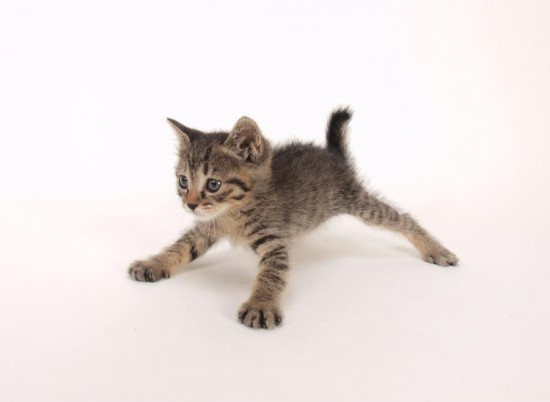
Many cat owners can identify with the ordeal they have to face each time they need to bathe their cat. Generally, if cats are rarely bathed, they will become easily frightened and try all means to escape while you try to bathe them. It's quite common for cat owners to get cat scratches during a cat bath!
If you start bathing your kitten when he is about 12 to 16 weeks old and then once every 3 to 4 months, he will become used to the routine and will not resist badly when you try to bathe him.
For adult cats who rarely get bathed, bathtime can be an ordeal for both cat and owner. To reduce this ordeal to some degree, being prepared and having someone to assist you will help a lot.
Here are the items you should have ready before you start:
- Nail clippers
- Cat brush
- Non-slip metal or stiff plastic screen for cat to stand on
- Mineral oil or eye ointment
- Cotton balls
- Two washcloths
- A few large towels
- Cat-safe shampoo
- Coat conditioner
HERE'S A STEP-BY-STEP GUIDE ON HOW TO BATHE YOUR CAT
Decide Where You Want to Bathe Your Cat - The bathtub, bathroom sink or kitchen sink are all suitable, but you must have a spray attachment at whichever choice you select. If you don't want to have to lean over while bathing your cat, the kitchen sink will be a better choice.
Close Off and Clear The Area - If possible, close all doors and openings so that your cat doesn't run out if he should panic. Clear all breakable items in the area as a panicked cat can easily run over your stuff and break them.
Set Your Attitude and Mindset - The key to reducing stress to your cat (and yourself) during bathtime is to be patient, sympathetic and be loving to your cat. Impatience and an angry tone is only going to make your cat more frightened and he will react accordingly.
Allocate more time when you bathe your cat so that you don't find yourself frustrated trying to handle your cat and rushing for a deadline at the same time.
Oh, and another thing, be prepared to get very wet!
Trim Claws - Gently clip his claws. This will help to reduce scratches on you if he should panic.
Brush Fur - Gently brush his fur to remove as much loose fur as possible.
Protect The Eyes - Place 1 or 2 drops of mineral oil or eye ointment in each of your cat's eyes. This will prevent any chemical irritation if shampoo should get into the eyes.
Protect The Ear Canal - Place a cotton ball in each ear to prevent water from entering his ear canal.
Place The Non-Slip Screen into your bathtub or sink and then gently carry your cat and place him on the screen.
Wet the Fur - Turn on the water slowly and let it run until the water is warm (not hot). Hold the sprayer very close to your cat's skin so that the water doesn't spray all over him and make him frightened.
If someone is helping you, he/she can hold up the front legs while you wet the fur on the stomach and between the legs.
Apply Shampoo & Rinse - Ensure that your cat's fur is sufficiently wet before shampooing, so that the shampoo can lather easily. Start lathering from the neck and work backwards towards the tail.
To wash your cat's face, wet a washcloth and add a tiny amount of shampoo. Gently wipe all over the face, avoiding the eye area. To wash the eye area, wet a cotton ball with clean water and gently wipe around the eye area. To rinse off the lather on the face, wet another clean washcloth and gently wipe off the lather.
Make sure to rinse and remove all traces of shampoo from your cat's body and face. Shampoo residue will cause irritation and itching.
If your cat is extremely dirty, you may have to shampoo it and rinse again.
Apply Coat Conditioner & Rinse - Coat conditioner is especially recommended for long-haired cats. It conditions the hair and makes brushing the hair smoother. Rinse thoroughly. The coat should feel squeaky clean and not slick or slippery after rinsing.
Drying Off - Run your hands down the back, legs and tail to remove excess water. Use a large towel to scoop your cat up, leaving only the head outside the towel. Place on a cabinet or table and gently towel dry.
Grab another clean dry towel, wrap him up with it and hold him. Hold him this way until he warms up. This also helps to calm the cat down.
If you are running out of time and would like to use the hair dryer, set it to a low or cool setting. If you set it to high and hot, your cat will become very frightened. Make sure not to point the hair dryer at his face and always hold the hair dryer at least 1 foot away from its coat.
Brush The Hair - When the hair is mostly dry, you can start to gently brush the hair.
 How To Exercise Your Cat
How To Exercise Y
How To Exercise Your Cat
How To Exercise Y
 The Chihuahua And Dental Issues
The Chihuahua And
The Chihuahua And Dental Issues
The Chihuahua And
 Fruits and Veggies For Your Pet? You Bet!
Fruit for your dog?
While fruits and veggies for some pets
Fruits and Veggies For Your Pet? You Bet!
Fruit for your dog?
While fruits and veggies for some pets
 How A Family Dog Can Help A Childs Development
How A Family Dog
How A Family Dog Can Help A Childs Development
How A Family Dog
 Ten Types Of Allergies That Can Affect Dogs
Ten Types Of Alle
Ten Types Of Allergies That Can Affect Dogs
Ten Types Of Alle
Copyright © 2005-2016 Pet Information All Rights Reserved
Contact us: www162date@outlook.com